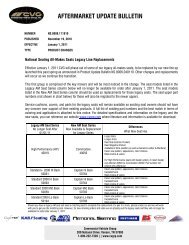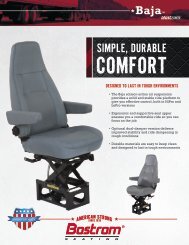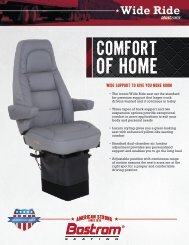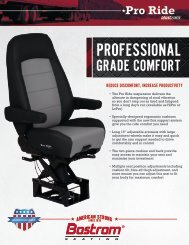supplier quality and packaging requirements manual - Commercial ...
supplier quality and packaging requirements manual - Commercial ...
supplier quality and packaging requirements manual - Commercial ...
Create successful ePaper yourself
Turn your PDF publications into a flip-book with our unique Google optimized e-Paper software.
2.3.7.3 Sealing:<br />
2.3.8 Internal Part protection<br />
Acceptable methods of sealing <strong>manual</strong>ly-h<strong>and</strong>led totes are strippable reinforced<br />
tape or spot gluing. Alternative methods may only be acceptable with prior<br />
approval from the receiving plant locations.<br />
Parts must be secured <strong>and</strong> protected in the primary container <strong>and</strong> be free of damage upon<br />
delivery. Internal dunnage must not restrict part presentation to the operator.<br />
a. Whenever possible, paper-based dunnage shall be used.<br />
b. For part surfaces requiring plastic <strong>packaging</strong> materials, the material must be designed for<br />
recyclability <strong>and</strong> ease of segregation. All plastic <strong>packaging</strong> must be identified by resin<br />
type according to the symbology established by the Society of Plastics Industry (SPI).<br />
c. No foreign materials may be adhered to corrugated board or wood.<br />
2.3.9 Packaging Authorization Flow Chart<br />
See Attachment 1<br />
2.3.10 Expendable Packaging Data Sheet<br />
See Attachment 2<br />
2.3.11 Packaging-Shipping Trial Document<br />
See Attachment 3<br />
3.0 LABELING REQUIREMENTS<br />
3.1 Types of Labels<br />
There will be five different label types required of CVG <strong>supplier</strong>s, each depending on how the product is<br />
packaged. The examples described <strong>and</strong> shown are the preferred formats, however, the data fields are<br />
m<strong>and</strong>atory. Actual labels may vary consistent with the <strong>supplier</strong>’s printing capabilities.<br />
3.1.1 Primary Container Label<br />
This label is used to identify the primary container, whether it is a carton, tote, etc. containing the<br />
same part number. See Attachment 4 for an example.<br />
3.1.2 Master Load Label<br />
This label is to be used for all shipments of material, regardless of quantity of containers. This<br />
label functions to summarize the total quantity of a single part number or lot number of material.<br />
If more than one part number or lot number is included in the container, pallet, skid, etc., a Master<br />
Label for each part number or lot number shall be used. See Attachment 5 for an example.<br />
3.1.3 Mixed Load Label<br />
This label is used for containers, pallets, skids, etc. holding more than one single primary<br />
container of different part numbers. See Attachment 6 for an example.<br />
W.I. 7.4.3.1 Rev H Page 33 of 54<br />
Supplier Quality <strong>and</strong> Packaging Requirements Manual<br />
Printed Copies Uncontrolled








